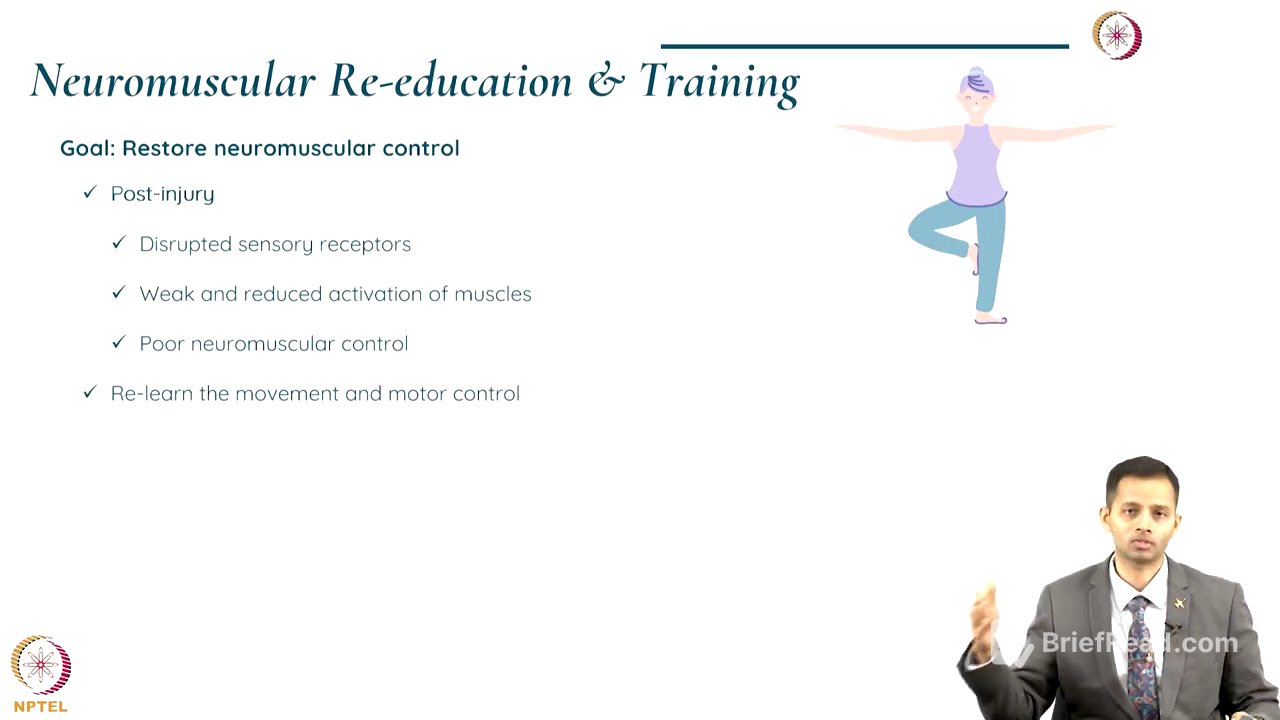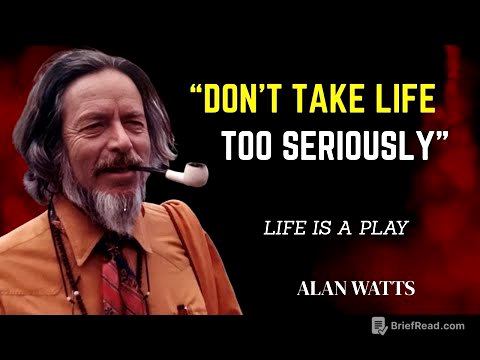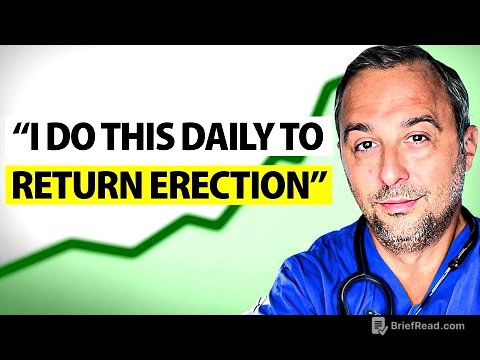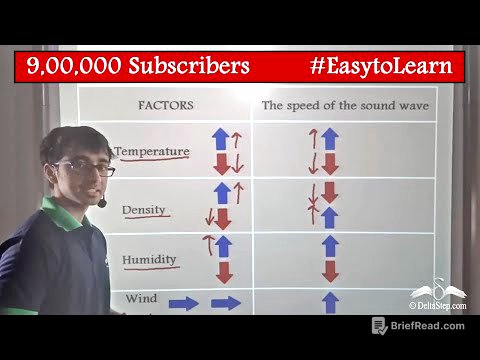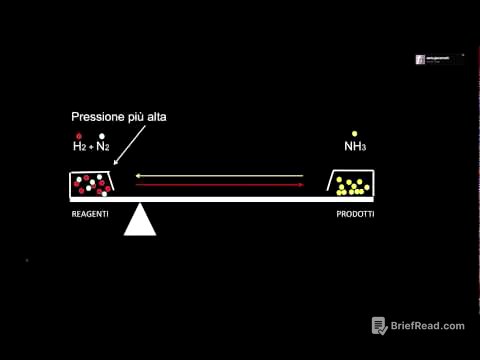TLDR;
This lecture provides an overview of advanced physical therapy techniques used in sports rehabilitation. It emphasizes the importance of objective assessments, personalized approaches, and integrated, evidence-based practices for accelerated return to sports and reinjury prevention. The lecture covers various techniques applicable in different phases of rehabilitation, from neuromuscular re-education and aquatic therapy in early phases to eccentric loading and plyometric training in later stages, along with screening methods like functional movement screens.
- Objective assessment tools are crucial for monitoring progress.
- Neuromuscular re-education is fundamental for restoring motor control.
- Advanced techniques should be chosen based on the phase of rehabilitation, tissue healing, and the athlete's specific needs.
Introduction to Advanced Physical Therapy Techniques [0:15]
The lecture introduces advanced physical therapy (PT) techniques for sports rehabilitation, highlighting the need for strategies that cater to the demands of sports. It emphasizes a shift from passive care to technically integrated protocols with objective criteria for accelerated return to sports, focusing on evidence-based and athlete-centered approaches. The goals of advanced PT include restoring function, preventing reinjury, accelerating return to sports, and integrating objective measurements with evidence-based practice.
Components of Advanced Rehabilitation Program [2:43]
An advanced rehabilitation program includes objective assessment tools like handled dynamometry, EMG-based recordings, and isokinetic dynamometry. Motor control training is a major component, emphasizing neural training and movement quality over quantity. Managing load is crucial, especially for overuse injuries, using data from advanced algorithms to calculate external load and acute to chronic load ratios. The program integrates functional movement with sports-specific performance, fostering collaboration between coaches, trainers, and therapists.
Rational Use of Advanced Techniques [4:57]
The rational use of advanced techniques depends on the rehabilitation phase, tissue healing, injury extent, and the demands of the sport. Accessibility to techniques, available facilities, and the athlete's level (professional, amateur) also influence the choice of techniques. Matching the method to the individual is important for effective outcomes.
Neuromuscular Re-education and Training [6:24]
In phase one, neuromuscular re-education and training are emphasized to restore motor control disrupted by sensory receptor damage. This involves breaking complex movements into simple ones and progressing gradually. Practical application includes range of motion exercises, balance exercises on different surfaces, and single leg balance, with visual feedback to correct position. Advanced techniques like EMG biofeedback and balancing tools can augment this re-education.
Stages of Motor Control Learning [9:44]
Motor control learning occurs in three stages: cognitive, associative, and autonomous. In the cognitive stage, the therapist explains the movement, its importance, and demonstrates the correct form. The associative stage involves the individual trying to match the demonstration with feedback. In the autonomous stage, the individual corrects themselves and performs the movement correctly without external feedback.
Aquatic Therapy [11:53]
Aquatic therapy facilitates functional recovery and therapeutic exercise in a water medium, suitable for various populations. Resistance is adjusted by varying the depth of immersion. It facilitates range of motion, provides three-dimensional movement, and reduces weight-bearing, aiding early mobilization and improving cardiorespiratory endurance and relaxation.
Blood Flow Restriction (BFR) Training [13:44]
Blood flow restriction training combines low-resistance training with blood flow occlusion to produce hypertrophy similar to high-intensity training. It involves reducing blood flow while occluding venous flow using a blood pressure cuff, creating a hypoxic environment. This is combined with low-intensity exercise (20-30% of 1RM) with high repetitions and short rest periods. Monitoring blood pressure is crucial to avoid compromising arterial supply. Ultrasound can be used to identify the pressure at which blood flow reduces.
Isokinetic Testing and Rehabilitation [17:21]
Isokinetic testing uses equipment to objectively measure torque produced by muscle groups, comparing it to the other side to assess symmetry. It measures torque, velocity, and symmetry, providing feedback to therapists and patients. It aids in monitoring stage-wise criteria for progression and can be used for concentric or eccentric activities. Commonly used in football to measure hamstring and quadriceps strength, it helps prevent recurrence and injury.
Eccentric Loading Techniques [19:40]
Eccentric loading techniques dynamically load muscles, causing them to lengthen and produce more force, important for deceleration forces in sports. Started in the late stages of rehabilitation (phase three), it improves sports performance in high-intensity deceleration, change in direction, and is integral to tendinopathy rehab. It can cause microtrauma and delayed onset muscle soreness (DOMS).
Plyometric Training [22:19]
Plyometric training uses eccentric contraction followed by rapid concentric contraction to improve explosive power. Examples include box jumps, skips, and medicine ball exercises. Used in the advanced strengthening phase (phase three), it requires a basic level of strength to avoid injuries and can also cause DOMS.
Instrument Assisted Soft Tissue Mobilization (IASTM) [24:07]
Instrument assisted soft tissue mobilization involves using instruments to assist in soft tissue mobilization, breaking scar tissue and fascial restrictions. Used in the remodeling phase or chronic cases, it aims to increase mobility and promote healing. Tools range from golf balls and foam rollers to commercially available IASTM tools.
Dry Needling [25:25]
Dry needling involves inserting monofilament solid needles into trigger points to elicit a twitch response, stimulating nerve endings and initiating spinal reflexes for pain relief. It has evidence supporting its use in chronic low back ache, neck, and shoulder pain.
Cupping Therapy [26:18]
Cupping therapy creates a vacuum force to cause vasodilation and extravasation of blood. Dry cupping is preferred for its non-invasiveness, causing circular rashes due to blood extravasation. Used in chronic musculoskeletal conditions, it reduces pain through pain control theory and nitric oxide release.
Functional Movement Screen (FMS) [28:12]
Functional movement screen uses seven movement patterns (deep squat, hurdle step, inline lunges, etc.) to assess functional movement and identify deficiencies. Movements are scaled and scored, with a score of 14 considered good. It guides exercise prescription and screens for movement efficiency during the preseason.
Virtual Reality (VR) in Rehabilitation [29:36]
Virtual reality in rehabilitation is an engaging way to motivate athletes, especially in concussion, neuro, and balance rehabilitation. It provides immediate feedback, allowing for on-the-go corrections and faster recovery.
Case Scenario: Hamstring Strain [30:25]
In a case scenario of a football player with a hamstring strain, cryotherapy and aquatic therapy can be used in phase one. Blood flow restriction training and isokinetic assessments can be used in phase two. Eccentric Nordic training and plyometric speed training should be incorporated in phase three to prevent reinjury.
Conclusion [32:42]
Innovation and evidence help provide better outcomes, and tailored rehabilitation is essential. Staying updated with emerging tools and using them appropriately, along with objective assessment, enhances feedback to patients and coaches. Advanced PT techniques can be used in screening, injury prevention, early rehabilitation, and accelerated return to sports protocols.
